This post may contain affiliate links. Please read our disclosure policy.
Soft, flexible gluten free tortillas are easy to make in any size, and they're perfect anywhere you'd use a corn tortilla, plus for burritos, tacos, and wraps. Roll them out with a rolling pin or a tortilla press, if you have one.
What makes this recipe special
The gluten free products market has really grown, enough that there are a number of packaged gluten free flour tortillas you can buy. But none of them equals the taste and texture of a homemade flour tortilla.
With this simple recipe, you can make these gluten free wraps as small as you like, and up to 10-inches in diameter—or as big as your skillet can hold. With these detailed step-by-step instructions, photos, and even a how-to video, you'll see that the dough is stable enough to shape however you like.
If you'd like to try a thicker version of a wrap, our recipe for gluten free flatbread is just as easy.
Recipe ingredients
Here's what you'll need to make these tortillas;
- Gluten free flour blend: You need a well-balanced all purpose mix here, like Better Batter's classic blend or Nicole's Best multipurpose blend. If you're using Nicole's Best, be sure to add 1 scant teaspoon xanthan gum separately, since it doesn't already contain it.
- Tapioca starch: Although your flour blend will already contain some tapioca starch, which all good blends do, you need to add more tapioca starch as a separate ingredient. It will help make the dough easier to handle and the tortillas a lot more flexible.
- Baking powder: Adds rise to your tortillas so they aren't flat. Check the date on the canister to make sure yours is fresh.
- Salt: Brightens the flavor of the tortillas.
- Virgin coconut oil: Adds richness, flavor and tenderness to the tortillas. Virgin coconut oil is the kind that comes in a jar and is solid at cool room temperature.
- Warm water: Adds moisture and brings the dry ingredients together. As the tortilla dough sits, it will absorb the water and become easier to handle. After the original 3/4 cup of water, only add more water very slowly if the dough is crumbly. Otherwise, you'll end up having to add too much tapioca starch to shape the tortillas and they may end up stiff and dry.
How to make gluten free tortillas
These flour tortillas are made simply and easily using a mixing bowl and a spoon, plus a whisk for the dry ingredients..
- In a large mixing bowl, place one of my recommended all purpose gluten free flour blends (including xanthan gum), tapioca starch, baking powder, and salt, and whisk to combine everything well.
- Add virgin coconut oil (the kind that’s semi-solid at room temperature), and mix it in to the dry ingredients using the tines of a fork. We want the fat evenly distributed throughout the flours until it resembles small peas or coarse sand.
- Add warm water, and mix to combine. The dough should be thick and should stick together well. If there are any dry bits, mix in a a bit more water just until it all comes together.
- Cover the dough and let it sit for about 20 minutes. This will make the dough easier to handle as the flours absorb the water. The dough will become a bit more stiff.
- Divide the tortilla dough into 4 equal pieces, and work with one at a time while the rest stay covered so they don’t dry out.
- When you’re ready to shape the dough, test each piece to see if it’s ready by sprinkling it lightly all over with tapioca starch, and beginning to roll it out. If it appears to crack and break, press it back together into a ball and repeat the process until the dough rolls smooth.
- Once the dough is smooth, sprinkle a flat surface lightly with tapioca starch, place the dough on top, and sprinkle again lightly with more tapioca. Roll out the dough into a rough round shape by working the rolling pin in all different directions from the center out. Touch the dough frequently as your roll it out as it’s easier to feel thicker lumps with your hands than it is to see them with your eyes.
- If you’d like neat, perfectly round circles, place the lid of a pot or an 8-inch metal cake cutter along the edges of the dough and press down to cut off the rough edges. Remove the excess dough.
- Heat a round 12-inch cast iron skillet over medium-high heat (or a nonstick skillet, but over medium heat so you don’t damage it) until water sprinkled in the center sizzles.
- Lift the raw, shaped tortilla carefully off the rolling surface and place it gently in the center of the hot skillet. Let it cook for about 45 seconds or until it begins to color in spots on the bottom (lift the corner up to peek). Using a wide spatula, flip the tortilla and cook on the other side for another 45 seconds or until it bubbles and takes on color in some spots.
- Remove the tortilla from the hot skillet and wrap it in a tea towel, or place it in a tortilla warmer (anything to keep it warm).
- Repeat with the other pieces of dough, rolling each piece of dough, cutting out rounds, and cooking each tortilla in the hot skillet.
- Stack the cooked tortillas right on top of one another, wrapped in a tea towel or in a tortilla warmer.
- Gather together all the scraps of raw dough from working with each of the original 4 pieces into a cohesive piece of dough, and roll it out again as before. Cut out 8-inch rounds, then gather and reroll the scraps once more. You should have a total of 6 8-inch tortillas by the end.
Expert tips
Use a cake cutter for clean lines
The secret to getting round tortillas with a clean, round edge is to use a cake cutter. One of those big old metal collars that look like really, really large cookie cutters.
It isn't necessary at all, but it does make for a more evenly-cooked tortilla. Once the rolled-out dough is very smooth, I use a 6-inch or 10-inch cake cutter to cut out rounds.
You can also use the lid of a large pot if it has sharp edges. Then, cut out the round cleanly, and remove the scraps to reroll with any remaining dough.
Start with a tortilla press
You can shape this gf flour tortilla dough with a simple tortilla press, if you prefer that to a rolling pin and a smooth, floured surface. Try slicing a quart-size zip-top bag in half and lining the top and bottom of your tortilla press with each half, to prevent the dough from sticking.
I prefer to roll out the dough using a rolling pin, since a tortilla press won't press the dough thin enough, or make a larger round than about 7-inches. So you'll still need to roll out the dough with some tapioca starch and a rolling pin after it comes out of the press.
I still like using a tortilla press, but only for thicker tortillas. It's great to use when I make fresh gluten free corn tortillas, which are naturally thicker. A press is also really handy when making rice-free cassava flour tortillas, which are more fragile and harder to roll out evenly.
Packaged gluten free tortillas
If you'd rather buy than make your gluten free tortillas, there are quite a few on the market these days. Many of them are available in stores, and my favorite one is only available to order online, but I don't order them often because the tortillas are expensive, and so is the shipping. Here are the brands I can recommend (although homemade is far superior):
My favorite store-bought tortilla brands
- Mission Gluten Free Tortillas: They're sold fresh, not frozen, and are sold in original and spinach herb flavors. They usually cost about $1 per tortilla, and come in a 6-pack. They also contain soy, but are gluten, dairy, and egg-free. They're sturdy enough and large enough to make a proper burrito. They do, however, taste like potato and taste better browned in a skillet than when simply heated in the microwave. Overall, a solid choice.
- Rudi's Gluten Free Bakery Plain Tortillas: These tortillas are usually sold frozen, are not nearly as easy to find as Mission, and appear smaller in size than Mission. They have a really classic flour tortilla taste, though, and perform well when heated. If they were easier to find, I'd probably buy them often.
- BFree Quinoa & Chia Seed Wraps: BFree brand products recently started showing up in my local grocery store, and they're usually pretty good quality. These tortillas are very flexible, and even though they look strange because of the obvious chia seeds, they don't taste “healthy.” They are more expensive, though: nearly $9 for 6 tortillas. They also now sell Sweet Potato Wraps and High Protein Wraps, but I haven't tried either of them.
- Siete Almond Flour Tortillas: Siete also has a cassava and coconut flour variety, but I really prefer the almond flour one. It tastes like almonds, but not in an overpowering way, and they're super thin and flexible. They usually cost about $1 a tortilla in a package of 8, and I now see Siete products at almost every major grocery store I visit.
- Mi Rancho Burrito Size Gluten Free Tortillas: These are by far the best packaged gluten free flour tortillas I have ever bought. They're super flexible, taste just like good flour tortillas should, and they're large enough to make a full-size burrito. The problem is that you can't find them in stores anywhere. I've only ever found them for sale on the mirancho.com website, and you can only buy a 3-pack of 6 tortillas each. The cost, with shipping, ends up being relatively high compared to others on my list ($30 for 18 tortillas), but it's worthwhile if you know you're going to use them regularly. Mi Rancho also makes really good gluten free corn tortillas with great corn taste, and those seem very available in brick and mortar stores.
- Maria & Ricardo's Gluten Free Quinoa Flour Tortillas: These are the newest addition to my repertoire, and they're excellent. They don't taste like quinoa flour to me, and heat really well. I find them in person at Whole Foods, and they're also available on amazon.com if you have Prime shipping for $30 for a 3 pack of 6 tortillas each (so the same price overall as Mi Rancho above). They are made in a facility that processes wheat, but on a dedicated gluten free line. They're “certified gluten free” by gfco.org, though, and I feel comfortable serving them to my family, but only you can make that choice for yours. Maria & Ricardo's also has other gluten free tortilla varieties available (among them are cauliflower tortillas and sweet potato tortillas), but I haven't tried any of them.
Ingredient substitutions
The best gluten free flour blend
I highly recommend using Better Batter all purpose gluten free flour blend in this recipe, or our “mock Better Batter” DIY blend if you can't or don't want to buy Better Batter itself. If you use a brand that I recommend against, especially Bob's Red Mill all purpose blends, you should not expect good results.
Assuming that you use an all purpose gluten free flour blend in this recipe that's dairy free and gluten free, this recipe makes tortillas that are vegan and gluten free. If you use Cup4Cup gluten free flour, a high starch blend, you will probably need more water or your dough will be crumbly.
Adding more tapioca starch/flour to a blend that already has some
In addition to an all purpose gluten free flour blend, this recipe needs added tapioca starch. Tapioca starch is also sometimes referred to as tapioca flour.
Every all purpose gluten free flour blend I recommend already has tapioca starch in it as an ingredient. You still need to add the additional tapioca starch called for in the recipe.
You may already have Expandex modified tapioca starch, which is chemically modified tapioca starch, because you bake yeast bread with our gluten free bread flour. If so, you can use Expandex in place of the additional tapioca starch, but you'll need less.
To use Expandex in place of the added tapioca starch, please use the following amounts in place of the all purpose gluten free flour blend and tapioca starch/flour in the recipe as written. You'll then use the remaining ingredients as written:
- 1 3/4 cups (245 g) all purpose gluten free flour
- 35 grams Expandex modified tapioca starch
Virgin coconut oil
This recipe calls for virgin coconut oil, which is the kind of coconut oil that is cold processed, preserving much of its antioxidant properties. It's solid at cool room temperature, about 72°F, which is what makes it appropriate for this recipe.
If you're sensitive to a slight coconut aroma that some solid coconut oil has, you can use triple-filtered coconut oil. It has no aroma at all.
In place of virgin coconut oil, you can use vegetable shortening. I like Spectrum brand nonhydrogenated vegetable shortening.
FAQs
No, flour tortillas aren't gluten free unless they specifically say that they're gluten free flour tortillas. Even if they say that they're gluten free, read the label carefully to be sure that you're buying the best brands of gluten free flour tortillas.
This tortillas recipe is very simple, and the most important ingredients are the gluten free flours. Here, you'll need both a high-quality all purpose gluten free flour like Better Batter, since these are primarily rice flour tortillas, plus more tapioca starch/flour (even though your blend already contains tapioca starch as one component).
For soft tortillas, make sure your raw dough is wet enough that you can use plenty of additional tapioca starch to roll out and shape the rounds. If your dough is crumbly, continue to add more warm water by the tablespoonful until it holds together and almost feels a bit greasy.
After the dough comes together, be sure to wrap it tightly in plastic wrap and let it rest for 20 minutes. Then, working with 1/4 of the dough at a time, shape it with plenty of extra tapioca starch, rolling it repeatedly until it's smooth and stable enough to lift from the rolling surface.
These flour tortillas are cooked in a hot, dry skillet. The best skillet to use is cast iron, but you can also use a nonstick skillet at a slightly lower temperature. You can also use a griddle like we do for our almond flour tortillas.
Make sure the skillet or griddle is very hot before you add the first raw, shaped round. If the skillet isn't hot enough, the raw dough will stick to the skillet.
These gluten free corn free tortillas freeze very well, after they're cooked. I don't recommend freezing the raw tortilla dough, since it's quick and easy to make, and is a relatively wet dough, so it will freeze quite solid.
To freeze the cooked flour tortillas, let them cool completely, then stack them one on top of the other. Then, wrap them tightly in freezer-safe wrap, and freeze until ready to use.
You can defrost them in the refrigerator overnight, and then refresh them by softening them in a hot skillet for a few moments on each side. Be sure the skillet is very hot before you place the tortilla on it, or the moisture on it will cause sticking.
You can also cover the frozen tortillas in a wet paper towel and pop them in the microwave until they're just pliable. It usually takes about 30 to 45 seconds, depending on your microwave's wattage, the size of each tortilla and how many tortillas are in the stack.
Gluten Free Tortillas Recipe

Ingredients
- 1 ½ cups (210 g) all purpose gluten free flour blend, I used Better Batter; click for more info
- 1 teaspoon xanthan gum, omit if your blend already contains it
- ⅝ cup (75 g) tapioca starch/flour, plus more for sprinkling
- 1 ½ teaspoons baking powder
- 1 teaspoon kosher salt
- 4 tablespoons (48 g) virgin coconut oil
- ¾ cup (6 ounces) very warm water (about 90°F), plus more by the tablespoon as necessary
Instructions
Make the tortilla dough
- In a large bowl, place the all purpose gluten free flour blend, xanthan gum, tapioca starch/flour, baking powder, and salt, and whisk to combine.
- Add the coconut oil, and toss it in the dry ingredients. With the tines of a large fork, break up the fat into small pieces about the size of small peas.
- Create a well in the center of the mixture, the water, and mix to combine. The dough should be thick. If there are any crumbly bits at all, add the remaining water by the tablespoonful.
- Knead the dough together and press it into a ball, cover with a moist tea towel, and allow to sit for 20 to 30 minutes. The dough will stiffen a bit as it absorbs more of the water.
- Heat a 10- or 12-inch cast-iron skillet (or a nonstick skillet over medium heat) over medium-high heat. The skillet should be hot enough to sizzle when you drip water on it.
Shape the tortillas
- Divide the dough into four equal pieces. Work with one piece of dough at a time, and cover the rest with a moist tea towel or plastic wrap to prevent them from drying out.
- Sprinkle at least 1 tablespoon of extra tapioca starch on a flat surface, place the first piece of dough on top, and sprinkle again with more tapioca starch. With a rolling pin, roll out the dough about ¼-inch inch thick.
- If the dough seems smooth, proceed with the next step. If it doesn't seem smooth, but instead has what appears to be cracks, gather the dough together again, sprinkle with more tapioca starch, and roll it out again until it appears smooth.
- Using a cake cutter or freehand with a pizza wheel or sharp knife, cut out a round approximately 8-inches in diameter. Assuming you're making approximately 8-inch rounds, you'll only cut out one round from each of the original 4 pieces of dough.
- Gather the scraps and set them aside with the other pieces of remaining dough. You will reroll all of the scraps together after you've worked with each of the original 4 pieces of dough.
Cook the tortillas
- Place the rounds one at a time in the center of the hot skillet. Cook on one side until bubbles begin to appear on the top surface and the tortilla darkens in color a bit on the underside (about 45 seconds).
- Using a wide spatula, flip the tortilla over, and cook on the other side until more bubbles form and the tortilla darkens on the underside (about another 45 seconds).
- Press down on the top of the tortilla to help it sear a bit. Remove the tortilla from the pan, place on large tea towel, and cover gently.
- Repeat the process with the remaining pieces of dough, including gathering and rerolling all the scraps together.
- You will make 1 8-inch tortilla from each of the 4 pieces of dough, and then up to 2 more 8-inch tortillas from the scraps for a total of 6 8-inch tortillas.
Make-ahead instructions
- If you don’t plan to use the tortillas right away, allow them to cool briefly so they are no longer hot to the touch. Then place them, still wrapped in the towel, in a plastic bag to seal in moisture. Serve the tortillas within a few hours.
- To freeze the tortillas, allow them to cool completely to room temperature.
- Stack them, wrap tightly with freezer-safe wrap, and freeze until you're ready to use. Allow to defrost at room temperature and refresh in a hot, dry skillet before serving.
Video
Notes
Nutrition
Nutrition information is automatically calculated, so should only be used as an approximation.

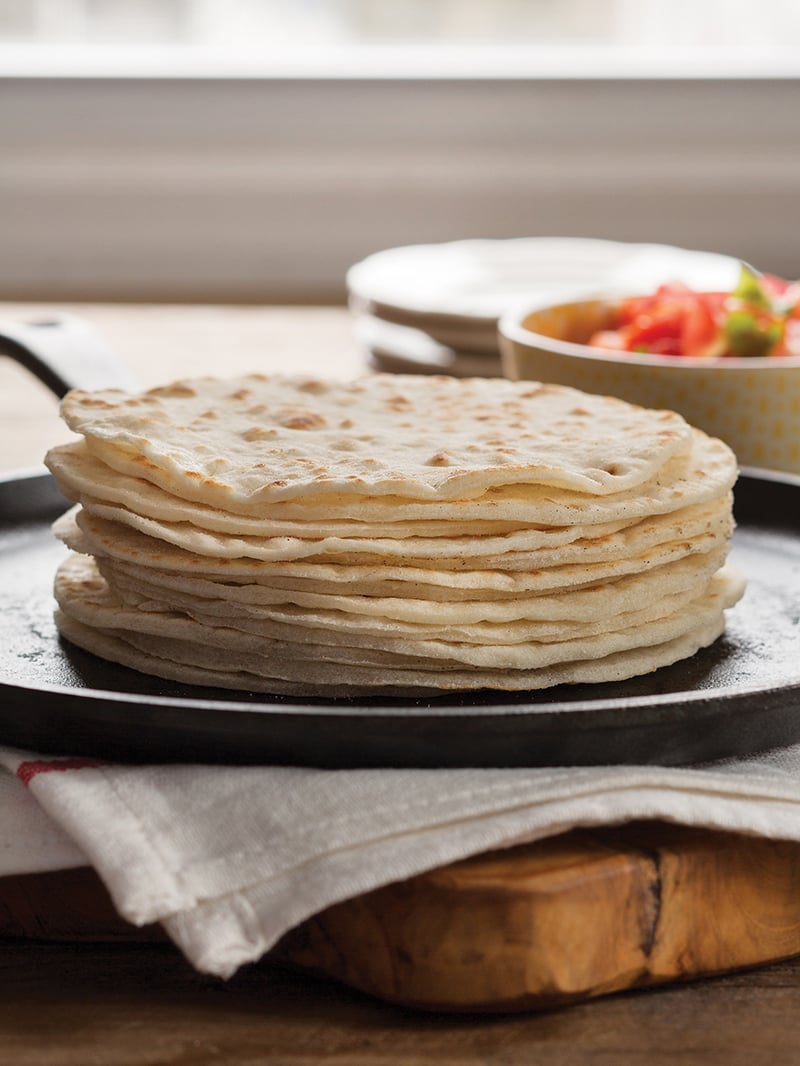

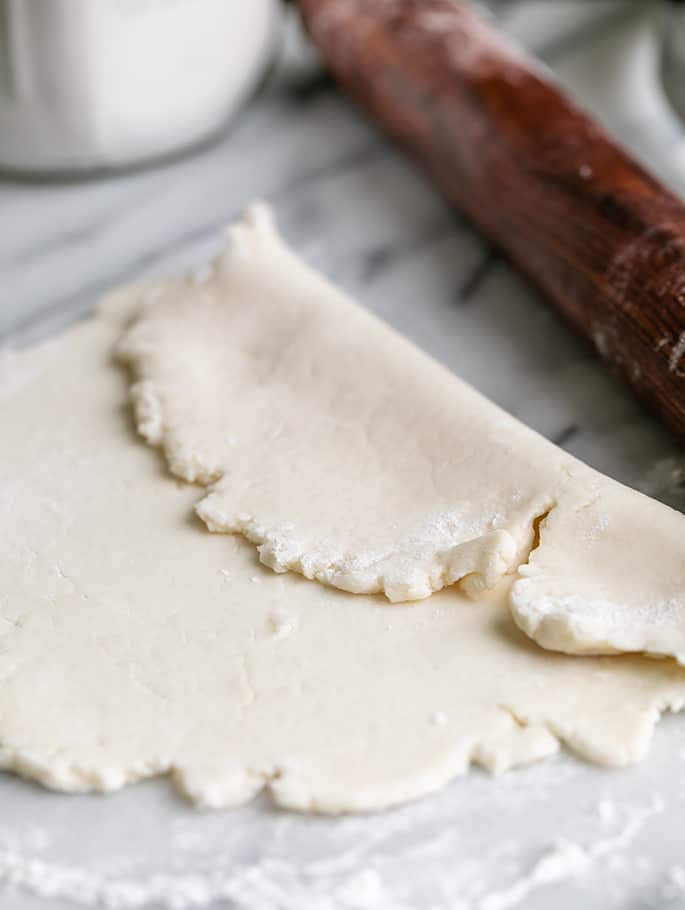
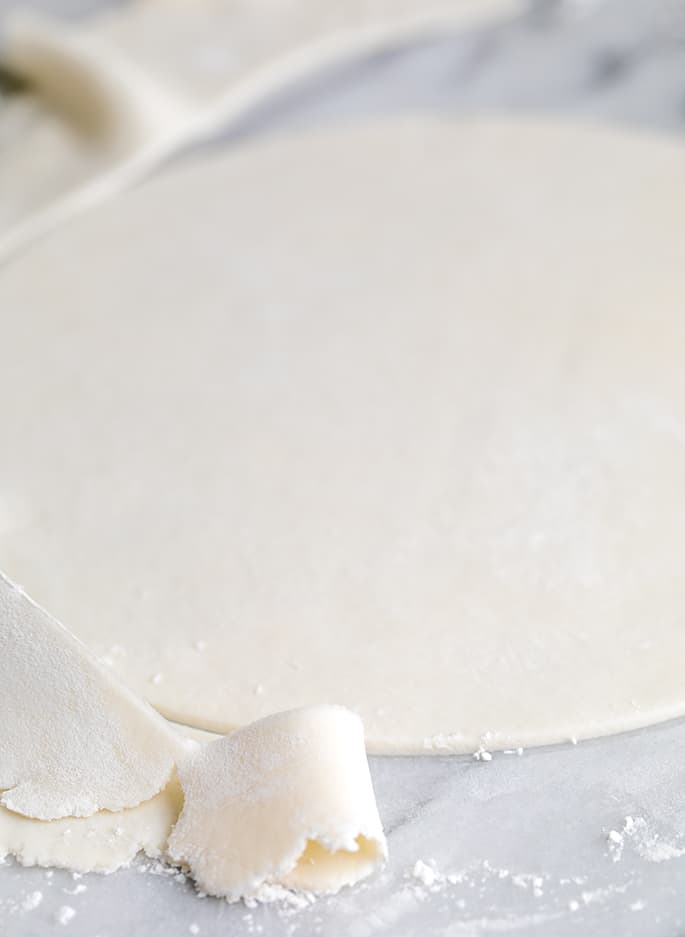
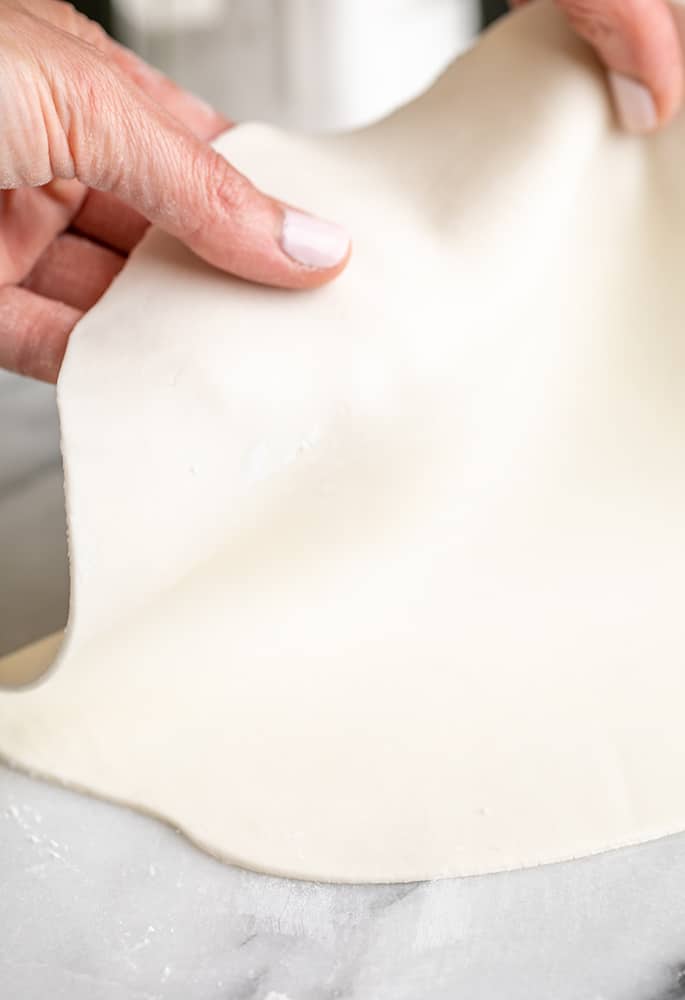
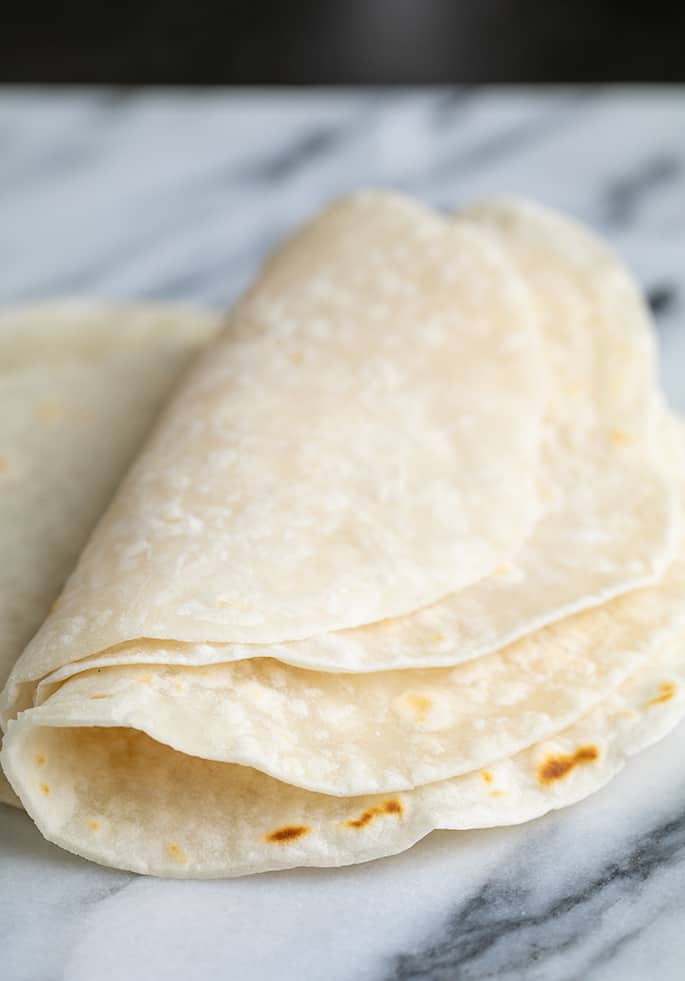
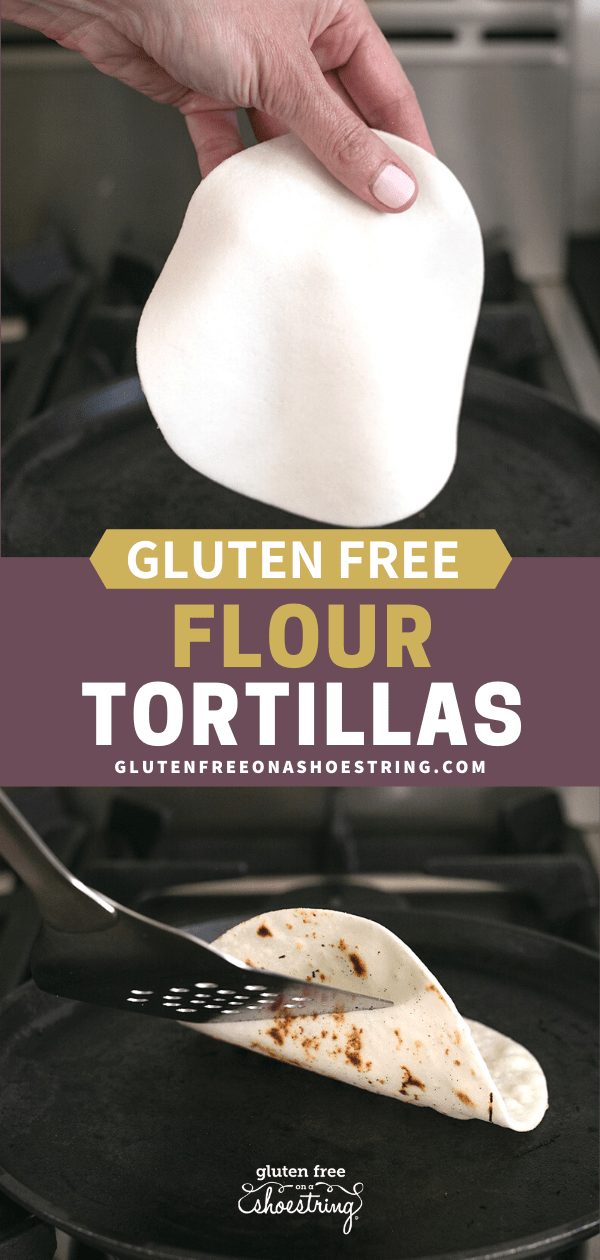
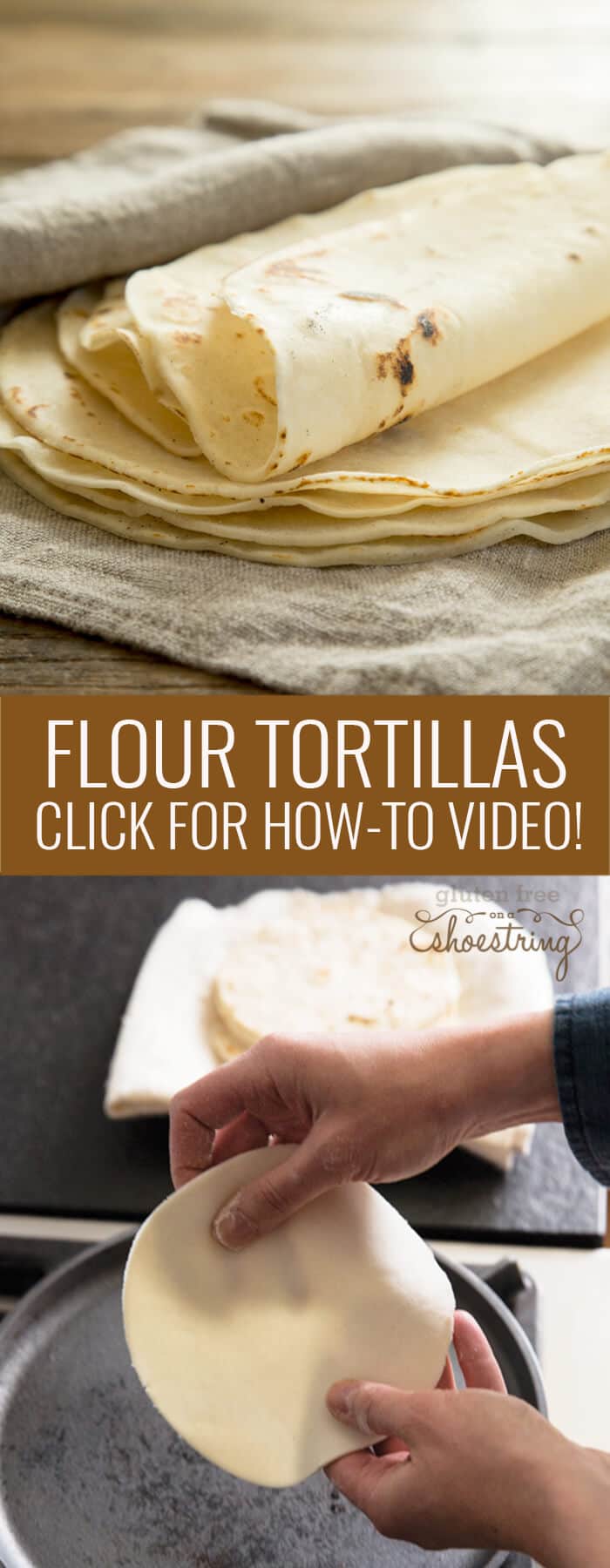
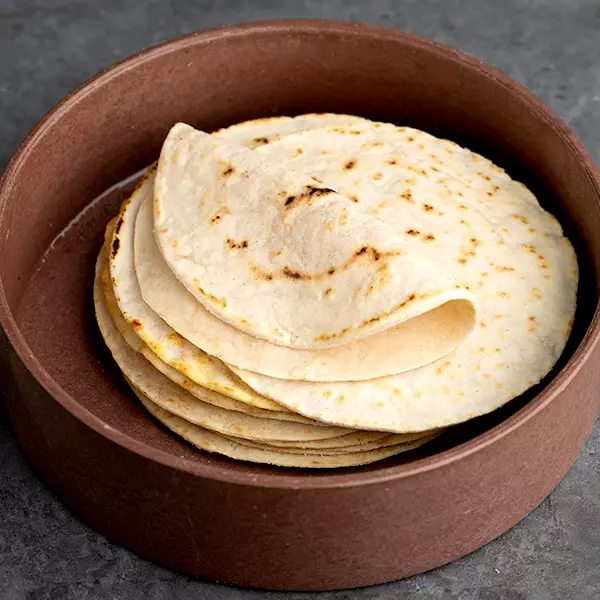
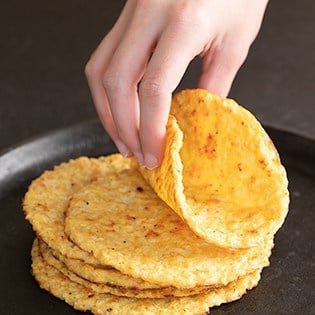
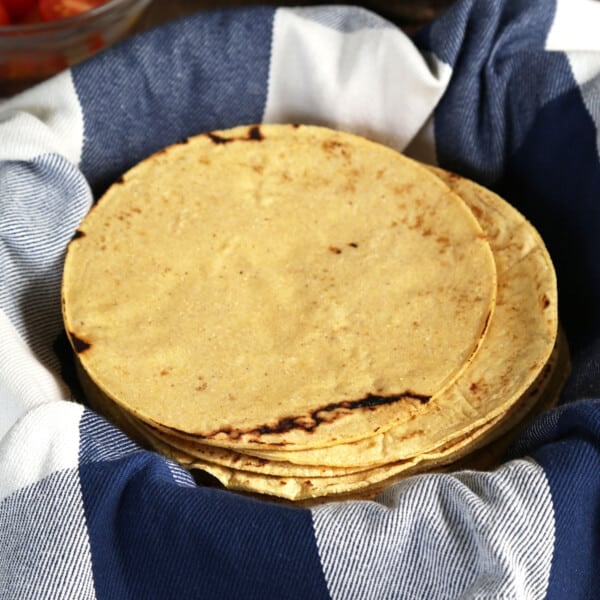










I love this recipe! I usually make corn tortillas at home, but for some reason I was really jealous while I was at Chipotle with some friends a few weeks ago… I was diagnosed before Chipotle even existed, so I’ve never had one of their enormous burritos and I could not stop thinking about them. If you ask me most days, I’d say “why would I want to add so many empty calories to my burrito bowl? I wouldn’t get a burrito even if I wasn’t Celiac” but on other, way less frequent days… its such a bummer that I *can’t* have it, even if I don’t really want it. And Chipotle tortillas look soooo soft and chewy, I was worried a gluten free one made in such a large size would end up cracking and falling apart. But I’d had such good luck with your other tortilla and flatbread recipes, so I decided to give it a try when this popped up on my feed. I grabbed my favorite burrito bowl from Chipotle, made this recipe, rolled out a massive 15″ flour tortilla, cooked it under my broiler, and had a Chipotle-sized burrito for the first time. It was like heaven. There is nothing better than eating exactly what you’re craving and Celiac can make that really hard, so thank you for the recipe <3
Thank you so much for sharing this experience, Mimi. You’re describing a phenomenon that I understand so well, but often struggle to explain in a shorthand way. It’s not just that you always loved burritos. The idea that it’s out of reach is what makes it way more important. That’s why I believe reliable gluten free recipes are so important for literally everything. Knowing that, if they can make it with gluten, so can we without, is sometimes all you need. If you decide to go for it, you know you can. And you did!
Hello, I was wondering if it would be possible to use olive oil instead of coconut oil? I loved the recipe but was look for a more neutral taste. Thank you so much!
Hi, Sierra, Olive oil has a very strong, recognizable flavor, actually. If you’re looking for a neutral flavor, I’d look for triple-filtered virgin coconut oil, which has absolutely not the slightest whiff of coconut. You could also use vegetable shortening. But you need a fat that is solid at room temperature, and low in moisture.
I’ve always used your old recipe with expandex. I can’t remember the amounts, can you please post?
Please see the section of the post with the heading: “Do I have to use the tapioca starch/flour?”, Katherine.
Nicole, made these for dinner tonight and my whole family cheered for them! It has been so long since I have made tortillas that were gluten free and… good. I have experimented with many recipes and have been so disappointed until now. Thank you! I have one question – the overall texture was wonderful, but the edges were a bit hard. Do you have any idea why? Could it be that I cooked them too long? Would so appreciate your thoughts.
That’s great to hear, Elaine! I have a few guesses about why the edges might have turned out hard/how you can prevent that in the future:
Hi Nicole,
Sorry but I didn’t know where else to ask this question. It’s about your won ton wrappers, I made them today but don’t want to use them for 3 days. Should I freeze them or are they fine in the fridge? Also when they are frozen will they separate easily so I can just take as many as I want? Thank you and by the way just like you said they were so easy to work with.
I’m glad you had a good experience with the won ton wrappers. I discuss the answer to your question in the post:
Can you please explain what difference it would make to use expandex instead of tapioca flour in this recipe. Is one better than the other
Sure, DJ. Using Expandex makes the dough a bit more stable and easier to handle when raw, and makes the tortillas a bit more stretchy. Plus, it also helps them stay fresh for a bit longer at room temperature. Hope that helps!
I love your recipes. Are you no longer posting the weights for your ingredients and now using cup measuring? I found that by cooking by weight my recipes were working much better.
Beth
Hi, Beth, I will always share weight measurements, and encourage readers to use them! In the new recipe format, you have to click “metric” or “customary” and the measurements change. You want “metric.” Just click that and it will reveal those values. I’m working on having it default to metric, but for now, just click!
Have you tried frying these tortillas? I absolutely crave the Arizona specialty–green chile cheese crisps, which are fried in hot oil, then smothered with green chile sauce that contains shredded pork. Also missing chimichangas, which are basically burritos that are fried in hot oil. My son and I seem to be buying out our small town grocery’s stock of gluten free flour tortillas every week and they are horrendously expensive. ANd don’t fry well.
I haven’t tried frying these, although I imagine they’d fry great once they’ve been cooked in the skillet. But you might like to try my recipe for “fry bread” or my recipe for “chalupas.” Just use the search function!
This is off topic but could you tell me if gluten free flour can be used to make a cream sauce, you know for thickening. I am just starting to learn about all this. At 73 I am fining it hard . I sure would appreciate an answer and am very sorry to bother you.
Thanks so much
Ps have been printing off your recipes hope I have luck.
Hi, Roberta, please use the search function to find things like gravy and other roux-based recipes. It’s all there, but for specific recipes, and the search function is very robust and it will bring back whatever you’re looking for.
Yes! Thank you, Nicole! From the video, I can tell that my tortillas always came out wrong because I cooked them way too long. It looks like there is still quite a bit of… clear…ish area. I’d been cooking them until they were totally white, all the way through, because I thought they weren’t thoroughly cooked otherwise. From the finished stack, I can tell I’d been rolling them too thin, also. Roll too thin + cook too long = tough, hard tortillas. It makes so much sense now! I can’t wait to try these again. We’ve been using the store bought tortillas, and they get mushy and stick to your teeth (ew). I can’t tell you how psyched I am about this. Really. Thanks so much :)
I absolutely love those lightbulb moments, Jess! I’m so glad you were able to troubleshoot. This is typically what’s needed when readers say that they followed the recipe “to a T” and it didn’t turn out well. It’s just that I’m not in a position to figure out where they deviated from the recipe, since they can’t tell me—because they don’t know either. :) I see many tortillas in your future. Well done!